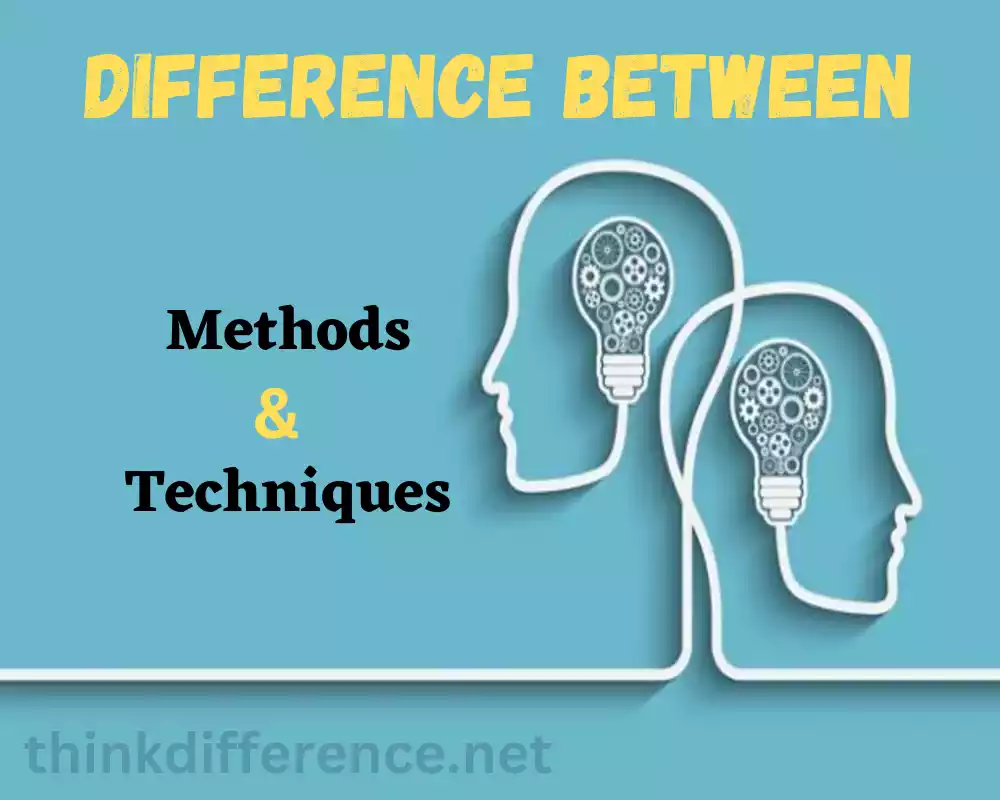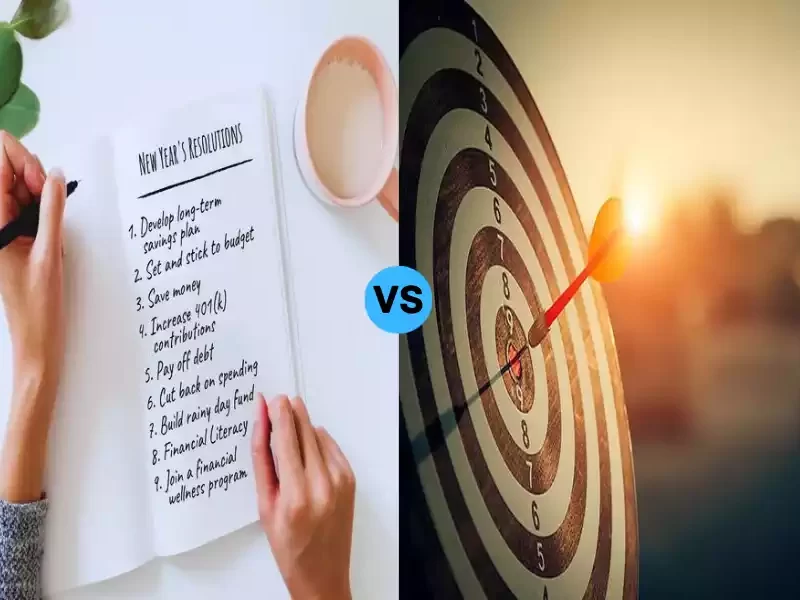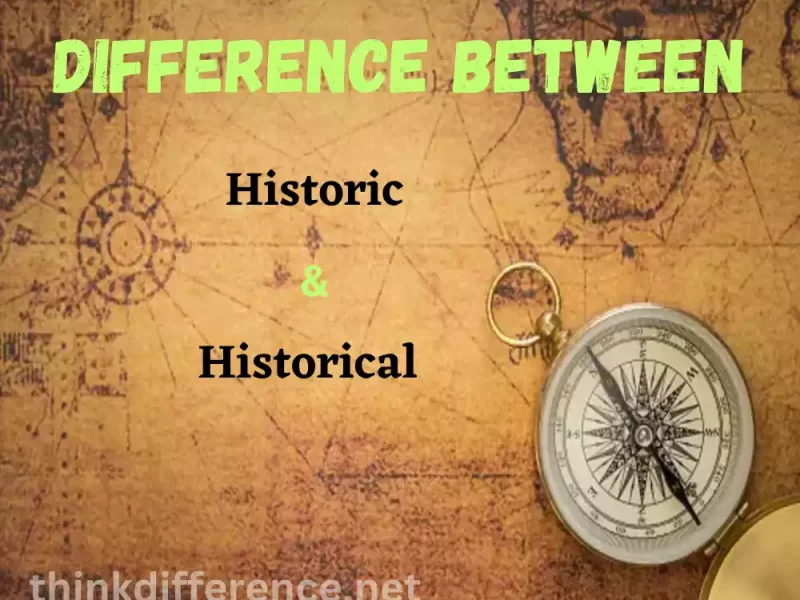Methods and Techniques provide a structured approach to tackle challenges and maximize opportunities. They serve as a roadmap, guiding us through the necessary steps and actions required to accomplish our objectives efficiently. By employing effective methods and techniques, we can streamline our efforts, optimize our resources, and achieve desired outcomes with greater ease.
Definition of Methods and Techniques
Methods: Methods refer to systematic procedures or approaches used to achieve a particular goal or solve a problem. They provide a structured framework for conducting research, carrying out tasks, or completing projects. Methods are defined as any series of actions or steps performed logically to achieve a set goal, using established techniques or methodologies within an industry or discipline. They often take the form of standard approaches.
Methods vary based on their intended context of application; research methods in particular often necessitate data collection, experiments, analysis and interpretation for proper usage. In project management, methods may include planning, organizing, executing, and monitoring activities. In education, teaching methods may encompass strategies and techniques used to deliver instruction and facilitate learning.
Methods provide a systematic and organized approach to accomplish objectives, and they often form the foundation of a particular process or discipline. They provide a structured way to achieve consistent results and are based on established principles and best practices within a specific field.
Techniques: Techniques refer to specific skills, tools or methods utilized for accomplishing specific tasks or attaining results within the larger framework of methodological inquiry. Unlike methods, which encompass a more comprehensive approach, techniques focus on the specific actions or procedures used to accomplish a particular step or aspect of a method.
Techniques are often practical in nature and may involve the application of specialized knowledge or expertise. They are typically employed to enhance efficiency, accuracy, or effectiveness in performing a specific task or achieving a desired result. Methods can be learned, refined and perfected through training and experience.
In various fields, techniques can have different meanings and applications. For example, in the field of painting, artistic techniques may refer to specific brushstrokes, color mixing methods, or shading approaches. In sports, techniques may involve specific movements, strategies, or training drills used to improve performance. In data analysis, statistical techniques may include methods for sampling, regression analysis, or hypothesis testing.
Techniques are specific actions, skills, or tools used within a broader method to accomplish a specific task or achieve a desired outcome. They are often practical in nature and are employed to enhance the execution and effectiveness of a method.
Importance of understanding the difference between Methods and Techniques
Understanding the difference between techniques and methods is of critical importance due to various reasons:
- Clarity in Communication: Clear communication is essential in any field or domain. Knowing the distinction between methods and techniques enables effective communication between individuals, teams, or disciplines. It ensures that everyone understands and interprets discussions, instructions, and guidelines accurately, avoiding confusion or misunderstandings.
- Strategic Planning and Decision-Making: Different situations require different levels of granularity in approach. Recognizing the disparity between methods and techniques helps in strategic planning and decision-making. It allows individuals or organizations to determine the appropriate level of detail needed for a given task, project, or problem, facilitating effective resource allocation and goal attainment.
- Tailoring Approaches: Understanding the difference between methods and techniques enables customization and tailoring of approaches. Methods provide the overall framework, while techniques offer specific tools or skills. By comprehending this disparity, individuals can select and combine suitable methods and techniques to match the unique requirements of a situation, leading to more effective problem-solving or goal achievement.
- Skill Development: Awareness of the difference between methods and techniques aids in skill development and learning. It allows individuals to identify the specific techniques required to improve their proficiency in a particular field or discipline. By focusing on acquiring the appropriate techniques within a sound methodological foundation, individuals can enhance their competence and expertise.
- Continuous Improvement: Recognizing the distinction between methods and techniques facilitates continuous improvement. It enables individuals or organizations to evaluate and refine their approaches systematically. By analyzing the effectiveness of methods and techniques separately, they can identify areas of improvement, optimize processes, and enhance outcomes over time.
- Cross-Disciplinary Application: Methods and techniques are applicable across various disciplines and industries. Understanding their difference promotes cross-disciplinary collaboration and knowledge sharing. It allows individuals to identify common principles or approaches that can be adapted from one domain to another, fostering innovation and interdisciplinary problem-solving.
Comprehending the difference between methods and techniques enhances communication, strategic planning, customization, skill development, continuous improvement, and cross-disciplinary collaboration. It empowers individuals to make informed decisions, select appropriate approaches, and achieve better outcomes in their respective fields.
What is Methods?
Methods are systematic processes or methodologies utilized to meet an objective or resolve an issue, from conducting research, completing tasks or finishing projects to standardisation based on established techniques in various disciplines or fields. They serve as an efficient logical way of conducting these actions or steps and reaching desired goals or solving issues.
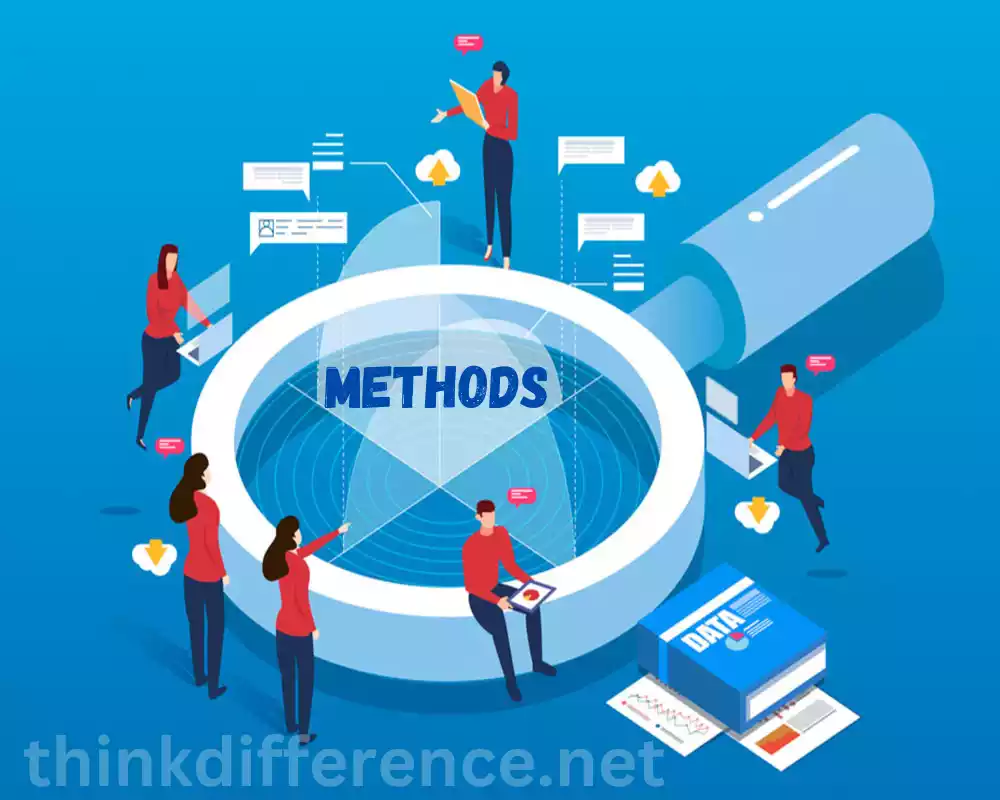
Methods may differ depending on their context of application, with scientific research necessitating data collection, analysis and experimentation before interpretation. Project management strategies focusing on planning, organizing and controlling activities may include strategies and tactics used for planning execution as well as controlling activities. In terms of education teaching methods often include strategies designed to impart instruction while aiding student learning.
Methods provide a systematic, rationale way of accomplishing goals, often as the cornerstone for an entire discipline or process. They serve to ensure consistent results through rules set by authorities in each field, with best practices being adhered to at each step.
Characteristics of Methods
Methods possess several key characteristics that define their nature and effectiveness.
Here are some important characteristics of methods:
- Systematic Approach: Methods involve a systematic approach to accomplishing goals or solving problems. They provide a structured framework that outlines the steps, procedures, and activities to be followed in a logical sequence.
- Organized and Sequential: Methods are organized and follow a specific sequence of steps or actions. Each step builds upon the previous one and contributes to the overall progression towards the desired outcome.
- Standardization: Methods often involve standardized processes and procedures. They are based on established principles, best practices, or industry standards within a particular field or discipline. This standardization helps ensure consistency and reliability in the application of the method.
- Reproducibility: These methods have been designed to be replicable and reusable that means others can replicate them to achieve similar outcomes. These provide teams or individuals with clear instructions and guidelines on how to achieve desired goals.
- Goal-Oriented: Methods are goal-oriented, focusing on achieving specific objectives or outcomes. They provide a structured path towards the desired result and help to align efforts and resources towards those goals.
- Context-Specific: Methods are often tailored to specific contexts or domains. They take into account the unique characteristics, constraints, and requirements of the particular field or problem at hand. Methods may vary across different disciplines and industries.
- Scalability: Methods can be scalable, meaning they can be adapted or applied to different scales or levels of complexity. They can be utilized for small-scale tasks or scaled up to address larger projects or broader challenges.
- Continuous Improvement: Methods are not static, they evolve and improve over time. As new knowledge, technologies, or insights emerge, methods can be updated and refined to incorporate these advancements. Continuous improvement is a key characteristic of effective methods.
- Documentation and Guidelines: Methods often come with documentation and guidelines to assist in their implementation. This documentation provides detailed instructions, tools, templates, or examples to support individuals or teams in applying the method effectively.
- Flexibility: While methods provide a structured framework, they also allow for flexibility and adaptation. They can be customized to fit specific needs or situations, accommodating variations or unique circumstances that may arise during implementation.
These characteristics collectively contribute to the effectiveness and reliability of methods in achieving desired outcomes, providing a structured and systematic approach to problem-solving, research, project management, and various other activities.
What is Techniques?
Techniques refer to any specific abilities, tools or methods employed in order to complete an action or achieve its intended result within an framework. Unlike methods, which encompass a more comprehensive approach, techniques focus on the specific actions or procedures used to accomplish a particular step or aspect of a method.
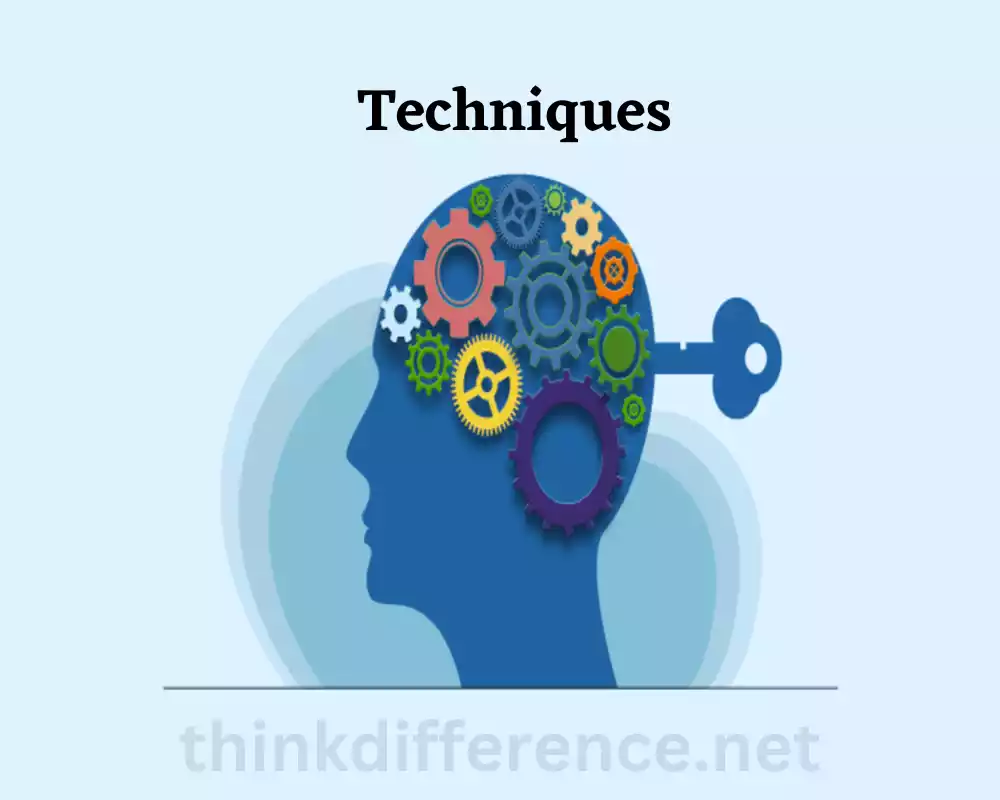
Techniques are often practical in nature and may involve the application of specialized knowledge or expertise. They are typically employed to enhance efficiency, accuracy, or effectiveness in performing a specific task or achieving a desired result. Techniques can be learned and refined with practice and perseverance.
In various fields, techniques can have different meanings and applications. For example, in the field of painting, artistic techniques may refer to specific brushstrokes, color mixing methods, or shading approaches. In sports, techniques may involve specific movements, strategies, or training drills used to improve performance. In data analysis, statistical techniques may include methods for sampling, regression analysis, or hypothesis testing.
Techniques are specific actions, skills, or tools used within a broader method to accomplish a specific task or achieve a desired outcome. They are often practical in nature and are employed to enhance the execution and effectiveness of a method.
Characteristics of Techniques
Techniques possess distinct characteristics that define their nature and utility.
Here are some important characteristics of techniques:
- Specificity: Techniques are particular ways of doing things. Each technique relates to one skill or instrument used for accomplishing specific tasks or reaching certain results. They address specific aspects or elements within a broader process or method.
- Practical Application: Techniques are practical and actionable. They provide practical skills, tools, or procedures that can be applied directly to enhance performance, efficiency, or effectiveness in executing tasks or achieving desired results.
- Skill-Based: Techniques often require the development and application of specific skills or expertise. They may involve the mastery of specialized knowledge, proficiency in using specific tools, or the ability to perform certain actions or procedures with precision.
- Learnable and Refinable: Techniques can be learned, practiced, and refined over time. They are not innate abilities but can be acquired through training, experience, and deliberate effort. Mastery of techniques can be enhanced through continuous learning and skill development.
- Contextual Relevance: Techniques are often developed within specific contexts or domains. They are designed to be relevant and effective in addressing challenges, achieving objectives, or optimizing performance within those specific contexts. Techniques may vary across different fields, industries, or disciplines.
- Enhance Execution: Techniques are employed to enhance the execution of tasks or activities. They provide specialized approaches, shortcuts, or strategies that improve the quality, efficiency, or effectiveness of performing specific actions within a larger process or method.
- Adaptability: Techniques can be adaptable to varying circumstances or conditions. While they have specific applications, they can be adjusted or modified to fit different situations or contexts, allowing for flexibility in their implementation.
- Continuous Improvement: Like methods, techniques can also undergo continuous improvement. As new insights, technologies, or approaches emerge, techniques can be refined, updated, or combined with other techniques to optimize performance or achieve better outcomes.
- Practical Knowledge Transfer: Techniques often involve the transfer of practical knowledge from experienced practitioners to others. They can be shared through training programs, mentorship, or documentation, allowing individuals to learn from established practices and apply them in their own work.
- Integration with Methods: Techniques are often integrated within a broader methodological framework. They serve as specific tools or actions used within a method to accomplish certain tasks or achieve particular aspects of the overall goal.
These characteristics collectively contribute to the practicality, effectiveness, and relevance of techniques. They provide individuals with actionable skills, tools, or methods to improve performance, efficiency, and effectiveness within specific domains or tasks. Techniques complement methods by providing focused actions or procedures to achieve desired outcomes.
Differences between Methods and Techniques
Methods and techniques could be summarised thus:
- Scope and Level of Detail:
- Methods: Methods are broader in scope and encompass a systematic approach or framework for achieving a goal or solving a problem. They provide a structured and organized way of conducting activities or processes.
- Techniques: Techniques are more specific and focused on the application of skills, tools, or methods within a particular step or aspect of a method. They are narrower in scope and provide practical actions or procedures to accomplish a task or achieve a desired outcome.
- Function and Purpose:
- Methods: Methods serve as a foundation or overarching strategy to guide the overall process. They outline the general approach and principles to be followed, providing a structured roadmap for achieving the desired outcome.
- Techniques: Techniques serve as practical tools or skills used within a method to enhance performance, efficiency, or effectiveness. They provide specific actions, procedures, or specialized knowledge to execute a task or achieve a specific aspect of the overall goal.
- Applicability and Adaptability:
- Methods: Methods are often applicable across different situations, contexts, or disciplines. They provide a general framework that can be adapted and customized to fit specific needs or requirements.
- Techniques: Techniques are more context-specific and may vary depending on the field, discipline, or task at hand. They are often developed and refined within specific domains and may not have direct applicability outside of their intended context.
- Level of Learning and Expertise:
- Methods: Understanding and implementing methods typically require a broader understanding of principles, concepts, and the overall process. Mastery of methods involves a deeper level of knowledge and expertise.
- Techniques: Techniques can be learned, practiced, and refined at a more granular level. They often involve acquiring specific skills, tools, or procedures and can be developed and improved with focused training or experience.
Methods provide a structured approach or framework for achieving a goal, while techniques are specific skills, tools, or methods used within that framework to accomplish specific tasks. Methods are broader, guiding the overall process, while techniques are more focused on practical actions and specialized knowledge.
Understanding the distinction between methods and techniques enables individuals to effectively plan, execute, and optimize their processes or problem-solving approaches.
Similarities of Methods and Techniques
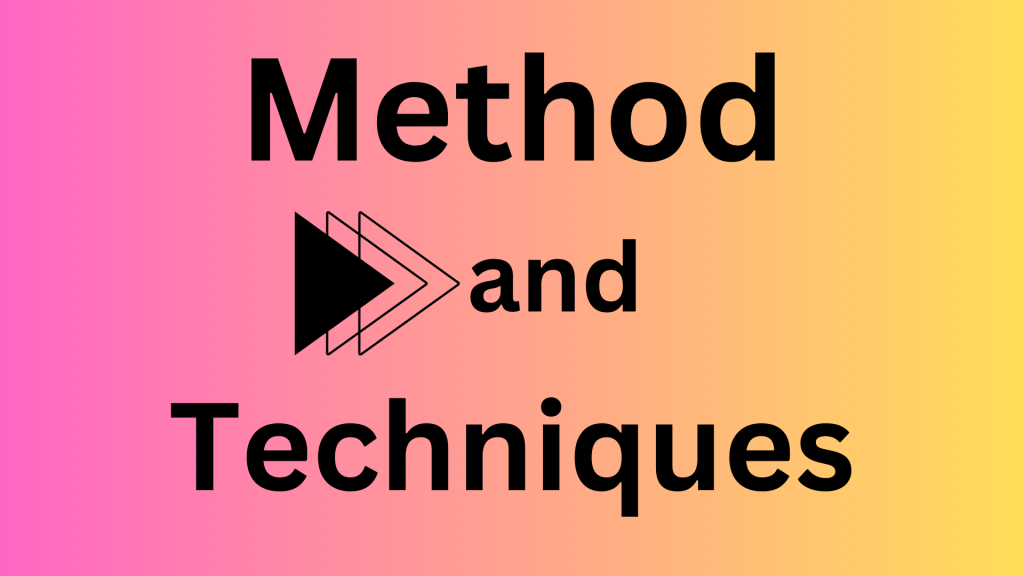
While methods and techniques have distinct characteristics, they also share some similarities.
Here are a few key similarities between methods and techniques:
- Purpose: Both methods and techniques are employed to accomplish specific goals or objectives. They are used to solve problems, achieve desired outcomes, or optimize performance in a particular field or context.
- Support: Both methods and techniques provide support and structure for achieving desired results. They offer systematic approaches, frameworks, or procedures that guide individuals or teams in their actions and decision-making processes.
- Integration: Methods and techniques can be integrated and used together. Techniques often serve as specific tools or actions within a broader method. They complement each other to form a comprehensive approach to problem-solving or task execution.
- Contextual Relevance: Both methods and techniques are developed and applied within specific contexts or domains. They are designed to be relevant and effective in addressing challenges, achieving objectives, or optimizing performance within those specific contexts.
- Continuous Improvement: Methods and techniques are subject to continuous improvement. As new knowledge, insights, or technologies emerge, both methods and techniques can be refined, updated, or adapted to enhance performance and align with evolving needs or best practices.
- Flexibility: Both methods and techniques can exhibit flexibility. While they provide structured approaches or specific actions, they can also be customized or adapted to fit varying situations, challenges, or requirements.
- Learnability: Both methods and techniques can be learned and acquired. They require individuals to develop knowledge, skills, and expertise through training, practice, and experience.
- Application: Both methods and techniques are applied in practical settings. They are not merely theoretical concepts but have practical applications that are aimed at achieving tangible outcomes or results.
Techniques and methods each have their own distinct attributes, yet often work harmoniously together. Methods serve as broad concepts or frameworks while techniques serve as specific tools within that framework. Integrating techniques and methods helps maximize problem-solving efficiency as well as decision making speed as well as performance enhancement across several different areas.
Choosing the right Method and Technique
Choosing the right Method and Technique is crucial for achieving desired outcomes and optimizing performance.
Here are some factors to consider when selecting the appropriate method and technique:
- Clear Objectives: Determine your desired outcomes by clearly outlining your objectives. Knowing exactly what it is you wish to do will aid your decision-making process and enable you to select an approach and method which best meets them.
- Context and Constraints: Before selecting and employing any method or approach to address an issue or project in its entirety, carefully assess its individual context with regards to any restrictions or limits it poses. Take time constraints into account as well as requirements of organization in your approach and any essence or central idea behind what you’re working on that could alter this choice of method and strategy.
- Skills and Expertise: Assess both your own expertise as well as that of colleagues, then select an approach and strategy compatible with these. Consider further training if required so as to implement your chosen methodology more successfully.
- Reliability and Compatibility: Assess the validity and compatibility of various strategies or tactics with your area of expertise or industry, such as methods from best practices in that space that meet goals or needs in mind.
- Ability and Flexibility: Evaluate how easily and adaptability your method or technique adapts and responds to unexpected circumstances or changing requirements. Opting for one which allows adjustments will ensure maximum efficiency in a dynamic environment.
- Expertise and Skills: Review your past successes, experiences, evidence from case studies or research and any proven strategies which may increase chances of success).
- An Iterative Approach: Recognizing that choosing a method or technique could require taking an iterative approach is critical when developing strategy or tactics for continuous improvement. As insights, feedback and discoveries surface, be adaptable in adapting or refining strategies accordingly and open to trying out new things while revalorising old strategies and approaches as you go along.
- Consultative Approach: Make decisions more collaboratively by including experts, key stakeholders and colleagues into your process for making choices. Gather their advice, input, opinions and thoughts – collaborative discussions offer invaluable insight that may aid you in making more informed choices.
Remember that there’s no single solution that fits everyone. The appropriate methods and approaches depend on factors like context goals, objectives, limitations. By considering all aspects and undertaking a rigorous selection process you are more likely to identify an efficient strategy to meet objectives more successfully.
Conclusion
Methods and Techniques is a fundamental skill. By choosing the right approach, overcoming challenges, and embracing innovation, individuals and organizations can unlock their true potential. Harnessing the power of methods and techniques is the key to shaping a successful future.

